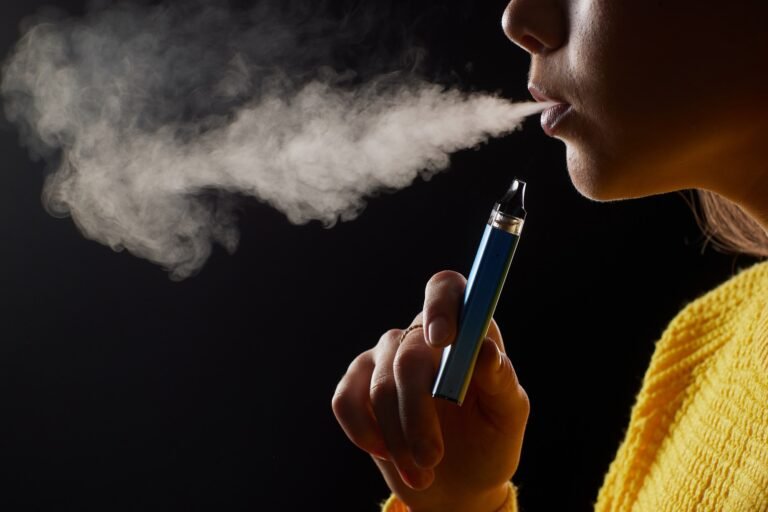A recent study published in JAMA Network Open examines how salt-based nicotine formulations and menthol flavors affect nicotine levels and the subjective experience of using e-cigarettes in young adults.
Study: E-cigarette nicotine delivery in young adults with nicotine form, concentration and taste: a randomized crossover clinical trial. Image credit: sergey kolesnokov / Shutterstock.com
E-cigarette use in young adults
Initially, e-cigarettes were marketed as a safer alternative to conventional cigarettes. However, young adults have become the primary consumers of e-cigarette products compared to those of any other age group, leading to e-cigarettes being the most commonly used tobacco product among young American adults.
In 2021, 20% of young adults were current vapers, while 10% of middle and high school students reported using e-cigarettes in 2023. Early use of e-cigarettes increases the risk of addiction, as daily vaping is currently reported by nearly 50% of young adults and 25% of teenagers in the United States.
Although the concentration of free base nicotine in e-cigarettes is up to 90% lower than that in traditional cigarettes, the incorporation of various additives leads to the formation of nicotine salts and non-tobacco aromas that facilitate nicotine addiction. As a result, nicotine inhalation through e-cigarettes is smoother and easier, which increases their palatability for continued use.
This innovation allowed e-cigarettes to be marketed with a nicotine concentration approximately three times higher than that of traditional free-base nicotine e-cigarettes, maximizing nicotine delivery.”
In conventional cigarettes, the presence of menthol reduces the harsh taste of nicotine while also increasing dependence. However, the effects of menthol in e-cigarettes remain unclear.
About the study
The current crossover randomized control trial (RCT) included 72 people aged between 21 and 25 years who reported e-cigarette use. Study participants received different salt-based or free-base nicotine products with 1% or 5% nicotine concentrations that were either menthol-flavored or tobacco-flavored.
In the first session, all study participants used their usual brand of e-cigarette. In the next eight sessions, study participants received any of the lab-formulated e-cigarette formulations. A five-minute inhalation period of 10 puffs was followed by 30 minutes of unlimited vaping.
Blood samples were collected at baseline, five, 10, and 35 minutes during each vaping session for plasma analysis. A visual analog scale (VAS) was also used to assess the intensity of positive effects such as desire, enjoyment, pleasure and satisfaction during the vaping session.
Study participants were given the Smoking Questionnaire (QSU) to measure their nicotine urges and cravings, as well as any withdrawal symptoms, during each vaping session. The duration, volume and frequency of inhalations were recorded during each session.
What did the study show?
The average age of the participants was 22 years and almost 60% of them were women. All study participants smoked at least one of the eight laboratory formulations.
Nicotine intake
Salt-based nicotine e-cigarettes were associated with the highest nicotine intake, especially at the 5% concentration. This resulted in mean plasma levels of 11.2 ng/mL and 17.2 ng/mL at five and 35 minutes, respectively.
Salt-based nicotine resulted in a 94% increase in plasma nicotine levels at five minutes, which then decreased to 53% after 30 minutes of unlimited vaping, compared to free-base products. 5% nicotine e-liquid increased plasma nicotine levels by approximately 50% and 65% at five and 35 minutes, respectively, compared to 1% nicotine.
The menthol scent increased plasma nicotine levels by 18% at 35 minutes, while no change was observed at five minutes.
Positive experience
Positive feelings were more likely with salt-based nicotine than with freebase e-cigarettes, with scores of 42.8 and 32, respectively. Similar findings were recorded with 1% and 5% nicotine products, with mean scores of 43.4 and 31.2, respectively. The menthol-flavored e-liquid had a more positive experience than the tobacco-flavored products, at 43.2 and 31.5, respectively.
Tobacco-flavored 5% freebase nicotine had the least positive subjective effects, while menthol-flavored 5% nicotine salts had the highest subjective experiences for nearly all positive measures.
Puff designs
Puff intensity was increased with nicotine salts and 1% concentration compared to the free base or 5% nicotine products.
The 1% e-liquid increased the total number of puffs by 47%, accompanied by a 20% increase in average puff duration. Similar increases were observed in mean and total puff volume and puff frequency.
Nicotine salt use resulted in 25% more puffs, while puff duration increased by 5% with approximately 10% higher mean and total puff volume. These effects were not attributable to the menthol taste.
All laboratory e-liquids reduced nicotine cravings and cravings, especially at the 5% concentration. The mean QSU-Desire score decreased from 16.7 with the 1% formulation to 15.4 with 5% nicotine products.
conclusions
The findings suggest that prevalent salt-based nicotine formulations may increase nicotine dependence among young adults who already use e-cigarettes and justify regulation.”
Today’s American vapes contain 5% nicotine as nicotine salts. Under standard and unlimited vaping, blood nicotine levels match or exceed those achieved by 10-12 puffs of a regular cigarette.
The positive experience and more intense high may increase the risk of addiction and abuse among young people who use these products. Thus, regulators are advised to consider limiting the level of acidic additives and menthol flavor present in e-cigarettes. This intervention could preserve the effectiveness of e-cigarettes for traditional cigarette users who want to quit, while limiting their appeal to young adults.
Journal Reference:
- Cho, YJ, Mehta, T., Hinton, A., et al. (2024). E-cigarette nicotine delivery in young adults with nicotine form, concentration and taste: a randomized crossover clinical trial. JAMA Network Open. doi:10.1001/jamanetworkopen.2024.26702.
